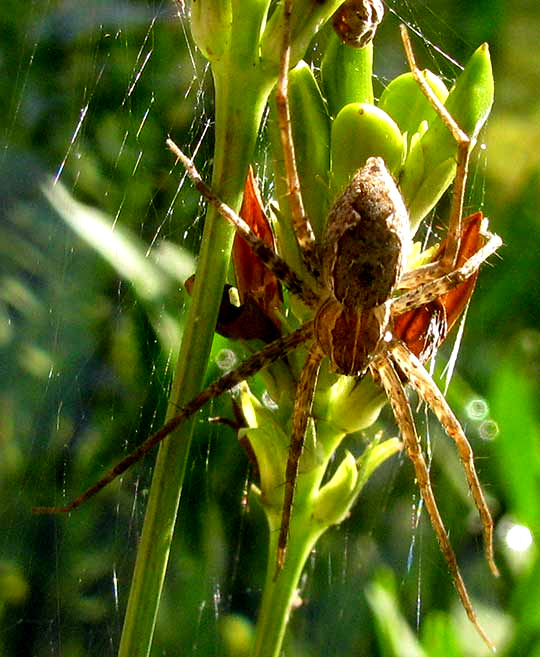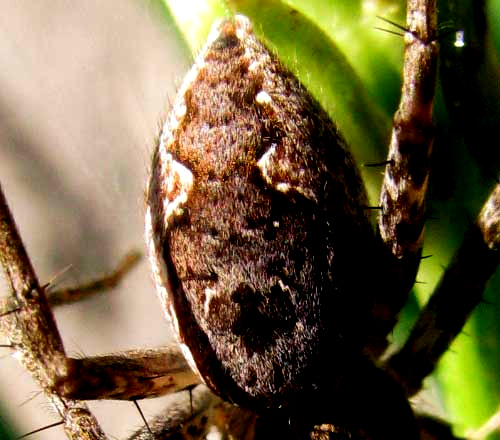Excerpts from Jim Conrad's
Naturalist Newsletter
from the June 8, 2014 Newsletter issued from the Frio Canyon Nature Education Center in the valley of the Dry Frio River in northern Uvalde County, southwestern Texas, on the southern border of the Edwards Plateau; elevation ~1750m (~5750 ft); N29.62°, W99.86°; USA
NURSERY WEB SPIDER
Our Memorial Day flash flood rearranged the Dry Frio River a little, scooping new depressions here, depositing new gravel bars there, and thoroughly obliterating many little green, scum-topped pools that for so long have provided teeming oases of life in a drought-stunned landscape.
In one spot where not long ago Water-willows, Justicia americana, emerged from a bone-dry bed of cobblestones, I was looking for emerging naiads on Water-willow stems now standing in fast-flowing, foot-deep water. I found none, but on a maturing Water-willow fruiting head I noticed the fair-sized spider in position atop her curious web, shown below:

The web appears to be more a haphazardly connected network of silk strands than the elegant orb webs and funnel webs we often admire. The spider, being so close to water and so large -- the body without legs about 10mm long (7/16ths inch) -- and with that conspicuous pale line traversing its front body segment, the cephalothorax, I felt sure that we had one of several species of fishing or water spider, of the Nursery Web Spider Family, the Pisauridae. However, it was different from the fishing spider species commonly seen resting on leaves floating on the Dry Frio's usually placid surface. You might enjoy comparing the above picture with that of our normally seen Six-spotted Fishing Spider archived at http://www.backyardnature.net/n/a/fishspid.htm.
A close-up of the brown and gray design on our Water-willow spider's abdomen is shown below:

Volunteer identifier Bea in Ontario nixed one after the other possible species it could have been in the same genus as our common Six-spotted Fishing Spider, Dolomedes, and then looked at other genera in the family. It turned out to be TINUS PEREGRINUS, which doesn't appear to have a commonly accepted English name, other than "nursery web spider," a general name applicable to all genera and species in that family.
Tinus peregrinus is distributed across the southwestern US from southern California to the southern tip of Nevada, and east to Texas and Missouri, and south into northern Mexico. A paper by James E. Carico on the genus Tinus, with maps and drawings, is freely available online at https://downloads.hindawi.com/journals/psyche/1976/079585.pdf.
Nursery web spiders in general are described as often semi-aquatic, sitting quietly for hours, legs spread out on vegetation or boat docks, or they may hunt actively in vegetation, and they have good vision.